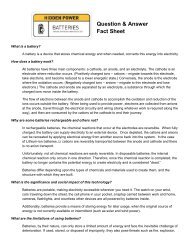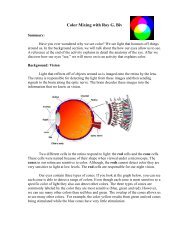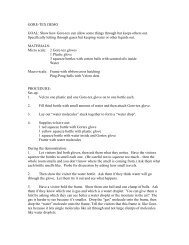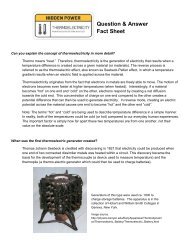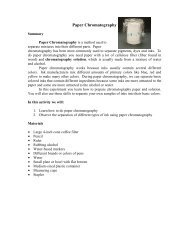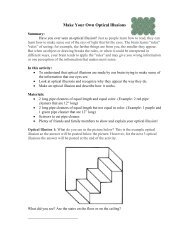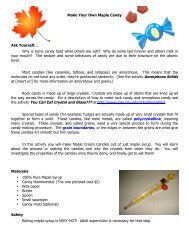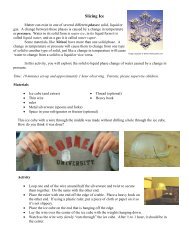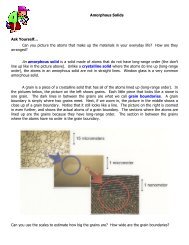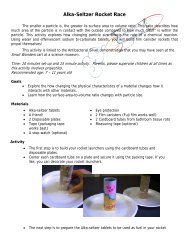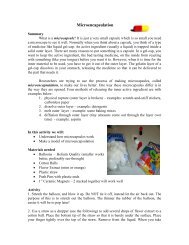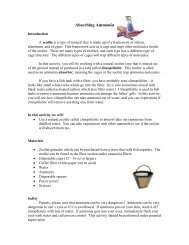Executive Summary Final - the Center for Nanoscale Science - an ...
Executive Summary Final - the Center for Nanoscale Science - an ...
Executive Summary Final - the Center for Nanoscale Science - an ...
Create successful ePaper yourself
Turn your PDF publications into a flip-book with our unique Google optimized e-Paper software.
IRG 1: Strain-enabled Multiferroics<br />
concept based on BiFeO3 has been demonstrated. The reversal of ferroelectric polarization also<br />
reverses <strong>the</strong> pl<strong>an</strong>e of easy magnetization, which c<strong>an</strong> <strong>the</strong>n be used in <strong>an</strong> exch<strong>an</strong>ge bias geometry<br />
to switch magnetic domains of a magnetic film on <strong>the</strong> surface.<br />
FUTURE DIRECTIONS: In addition to <strong>the</strong> specific future pl<strong>an</strong>s outlined above, here are <strong>the</strong><br />
broad outlines of what <strong>the</strong> IRG will be investigation.<br />
Hidden Symmetries <strong>an</strong>d Roto Properties: The structure of materials is described by a combination<br />
of rotations, rotation-inversions <strong>an</strong>d tr<strong>an</strong>slational symmetries. By recognizing <strong>the</strong> reversal<br />
of static structural rotations between clockwise <strong>an</strong>d counterclockwise directions as a distinct<br />
symmetry operation, , (see Figure 2) Gopal<strong>an</strong> <strong>an</strong>d Litvin have shown that <strong>the</strong>re are m<strong>an</strong>y<br />
more structural symmetries th<strong>an</strong> are currently recognized in right- or left-h<strong>an</strong>ded h<strong>an</strong>ded helices,<br />
spirals, <strong>an</strong>d in <strong>an</strong>tidistorted structures composed equally of rotations of both h<strong>an</strong>dedness. For example,<br />
although a helix or spiral c<strong>an</strong>not possess conventional mirror or inversion symmetries,<br />
<strong>the</strong>y c<strong>an</strong> possess <strong>the</strong>m in combination with <strong>the</strong> rotation reversal symmetry. Similarly, m<strong>an</strong>y <strong>an</strong>tidistorted<br />
perovskites possess twice <strong>the</strong> number of symmetry elements as conventionally identified.<br />
These new symmetries, referred to as “roto” symmetries, predict new <strong>for</strong>ms <strong>for</strong> roto properties<br />
that relate to static rotations, such as rotoelectricity, piezorotation, <strong>an</strong>d rotomagnetism. These<br />
symmetry insights enable a symmetry-based search <strong>for</strong> new phenomena, such as multiferroicity<br />
involving a coupling of spins, electric polarization <strong>an</strong>d static rotations. The Spaldin group has<br />
predicted piezorotation in strained LaAlO3 from first principles. Fennie has predicted Ca3Mn2O7<br />
to couple polarization <strong>an</strong>d magnetism through octahedral rotations (arXiv:1007.1003v1<br />
[cond-mat.mtrl-sci]). These new properties will<br />
be experimentally studied. Through seed funding,<br />
Trolier-Mckinstry <strong>an</strong>d Gopal<strong>an</strong> are initiating<br />
experiments to measure linear rotoelectric<br />
effect in a number of oxides.<br />
Figure 2: a. Gopal<strong>an</strong> has introduced a new symmetry<br />
operation, , to reverse static axial vectors, <strong>an</strong>d complete<br />
<strong>the</strong> missing entry (or<strong>an</strong>ge box). 1' is time reversal<br />
<strong>an</strong>d is spatial inversion symmetries. If <strong>the</strong> colors of<br />
a structural motif, as in b, denote static rotations, +Φ<br />
<strong>an</strong>d -Φ, <strong>the</strong> rotation reversal symmetry operation<br />
switches <strong>the</strong>m to -Φ <strong>an</strong>d +Φ, respectively, as in c.<br />
Ferroic Coupling <strong>an</strong>d <strong>the</strong> Role of Dimensionality<br />
in Layered Complex Oxides: This<br />
seed ef<strong>for</strong>t is based on our preliminary (unpublished)<br />
experimental discovery of <strong>the</strong> first ferroelectric<br />
material with finite n in a<br />
Ruddlesden-Popper (RP) series. Preliminary<br />
results on strained Srn+1TinO3n+1 are shown at<br />
right, where <strong>the</strong> well-known perovskite SrTiO3<br />
is <strong>the</strong> n = ∞ member of this series. Strained<br />
SrTiO3 c<strong>an</strong> be driven ferroelectric with a modest<br />
biaxial strain, yet as conjectured by Fennie<br />
<strong>an</strong>d Schlom, <strong>the</strong> n = 1 member of <strong>the</strong> series remains<br />
paraelectric <strong>for</strong> <strong>the</strong> same strain state. The<br />
m<strong>an</strong>ner in which ferroelectricity emerges as <strong>the</strong><br />
number of perovskite blocks n increases is a<br />
fundamentally interesting challenge in its own



